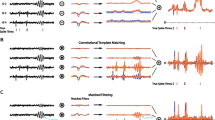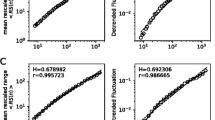Abstract
We present a computational algorithm aimed to classify single unit spike trains on the basis of observed interspikes intervals (ISI). The neuronal activity is modeled with a stochastic leaky integrate and fire model and the inverse first passage time method is extended to the Ornstein-Uhlenbeck (OU) process. Differences between spike trains are detected in terms of the boundary shape. The proposed classification method is applied to the analysis of multiple single units recorded simultaneously in the thalamus and in the cerebral cortex of unanesthetized rats during spontaneous activity. We show the existence of at least three different firing patterns that could not be classified using the usual statistical indices.
Similar content being viewed by others
References
Abeles, M., 1982. Local Cortical Circuits: An Electrophysiological Study. Springer Verlag, Berlin.
Abeles, M., 1991. Corticonics: Neural Circuits of the Cerebral Cortex. Cambridge Univiversity Press, Cambridge.
Bertram, R., Butte, M.J., Kiemel, T., Sherman, A., 1995. Topological and phenomenological classification of bursting oscillations. Bull. Math. Biol. 57(3), 413–439.
Bulsara, A.R., Elston, T.C., Doering, C.R., Lowen, S.B., Lindenberg, K., 1996. Cooperative behavior in periodically driven noisy integrate-fire models of neuronal dynamics. Phys. Rev. E 53(4), 3958–3969.
Capocelli, R.M., Ricciardi, L.M., 1971. Diffusion approximation and first passage time problem for a model neuron. Kybernetik 8(6), 214–223.
Celletti, A., Villa, A.E.P., 1996. Low dimensional chaotic attractors in the rat brain. Biol. Cybern. 74, 387–394.
Del Prete, V., Martignon, L., Villa, A.E.P., 2004. Detection of syntonies between multiple spike trains using a coarse-grain binarization of spike count distributions. Netw. Comput. Neural Syst. 15, 13–28.
Ditlevsen, S., Lansky, P., 2005. Estimation of the input parameters in the Ornstein-Uhlenbeck neuronal model. Phys. Rev. E 71(1), Art. No. 011907.
Eckhorn, R., Bauer, R., Jordan, W., Brosch, M., Kruse, W., Munk, M., Reitboeck, H.J., 1988. Coherent oscillations: A mechanism of feature linking in the visual cortex? Multiple electrode and correlation analyses in the cat. Biol. Cybern. 60, 121–130.
Fano, U., 1947. Ionization yield of radiations. II. The fluctuations of the number of ions. Phys. Rev. 72(1), 26–29.
Feng, J.F., Brown, D., 2000. Integrate-and-fire models with nonlinear leakage. Bull. Math. Biol. 62(3), 467–481.
Fortet, R., 1943. Les fonctions aléatoires du type de Markoff associées à certaines équations linéaires aux dérivées partielles du type parabolique. J. Math. Pures Appl. 22, 177–243.
Fujii, H., Ito, H., Aihara, K., Ichinose, N., Tsukada, M., 1996. Dynamical cell assembly hypothesis—theoretical possibility of spatio-temporal coding in the cortex. Neural Netw. 9, 1303–1350.
Gray, C.M., Singer, W., 1995. Visual feature integration and the temporal correlation hypothesis. Annu. Rev. Neurosci. 18, 555–586.
Hopfield, J.J., Brody, C.D., 2000. What is a moment? “Cortical” sensory integration over a brief interval. Proc. Natl. Acad. Sci. U.S.A. 97, 13919–13924.
Hopfield, J.J., Brody, C.D., 2001. What is a moment? Transient synchrony as a collective mechanism for spatiotemporal integration. Proc. Natl. Acad. Sci. U.S.A. 98, 1282–1287.
Inoue, J., Sato, S., Ricciardi, L.M., 1995. On the parameter-estimation for diffusion-models of single neurons activities. 1. Application to spontaneous activities of mesencephalic reticular-formation cells in sleep and waking states. Biol. Cybern. 73(3), 209–221.
Lansky, P., Rodriguez, R., Sacerdote, L., 2004. Mean instantaneous firing frequency is always higher than the firing rate. Neur. Comp. 16(3), 477–489.
Lansky, P., Sacerdote, L., Tomassetti, F., 1995. On the comparison of Feller and Ornstein-Uhlenbeck models for neural activity. Biol. Cyber. 73(5), 457–465.
Lindner, B., Longtin, A., Bulsara, A., 2003. Analytic expressions for rate and CV of a type I neuron driven by white gaussian noise. Neur. Comp. 15(8), 1761–1788.
Ricciardi, L.M., Di Crescenzo, A., Giorno, V., Nobile, A.G., 1999. An outline of theoretical and algorithmic approaches to first passage time problems with applications to biological modeling. Math. Japonica 50(2), 247–322.
Sacerdote, L., Sirovich, R., 2003. Multimodality of the interspike interval distribution in a simple jump-diffusion model. Sci. Math. Jpn. 58(2), 307–322.
Sacerdote, L., Zucca, C., 2003a. Threshold shape corresponding to a Gamma firing distribution in an Ornstein-Uhlenbeck neuronal model. Sci. Math. Jpn. 58(2), 295–305.
Sacerdote, L., Zucca, C., 2003b. On the relationship between interspikes interval distribution and boundary shape in the Ornstein-Uhlenbeck neuronal model. In: Capasso, V. (Ed.), Mathematical Modelling & Computing in Biology and Medicine (Proceedings of the V Conference ECMTB2002). Esculapio, Bologna, pp. 161–168.
Segundo, J.P., 2003. Nonlinear dynamics of point process systems and data. Int. J. Bifurcation Chaos 13, 2035–2116.
Shadlen, M.N., Newsome, W.T., 1998. The variable discharge of cortical neurons: Implications for connectivity, computation, and information coding. J. Neurosci. 18(10), 3870–3896.
Singer, W., Gray, C., Engel, A., Konig, P., Artola, A., Brocher, S., 1990. Formation of cortical cell assemblies. Cold Spring Harb. Symp. Quant. Biol. 55, 939–952.
Shimokawa, T., Pakdaman, K., Sato, S., 1999. Time-scale matching in the response of a leaky integrate-and-fire neuron model to periodic stimulus with additive noise. Phys. Rev. E 59(3), 3427–3443.
Shimokawa, T., Pakdaman, K., Takahata, T., Tanabe, S., Sato, S., 2000. A first-passage-time analysis of the periodically forced noisy leaky integrate-and-fire model. Biol. Cybern. 83(4), 327–340.
Shinomoto, S., Sakai, Y., Funahashi, S., 1999. The Ornstein-Uhlenbeck process does not reproduce spiking statistics of neurons in prefrontal cortex. Neur. Comp. 11(4), 935–951.
Softky, W.R., Koch, C., 1993. The highly irregular firing of cortical cells is inconsistent with temporal integration of random EPSPs. J. Neurosci. 13, 334–350.
Tuckwell, H.C., 1988. Introduction to Theoretical Neurobiology: I. Cambridge University Press, Cambridge.
Tuckwell, H.C., Wan, F.Y.M., Rospars, J.P., 2002. A spatial stochastic neuronal model with Ornstein-Uhlenbeck input current. Biol. Cybern. 86(2), 137–145.
Villa, A.E.P., Rouiller, E.M., Simm, G.M., Zurita, P., de Ribaupierre, Y., de Ribaupierre, F., 1991. Corticofugal modulation of information processing in the auditory thalamus of the cat. Exp. Brain Res. 86, 506–517.
Villa, A.E.P., Tetko, I.V., Hyland, B., Najem, A., 1999a. Spatiotemporal activity patterns of rat cortical neurons predict responses in a conditioned task. Proc. Natl. Acad. Sci. U.S.A. 96, 1006–1011.
Villa, A.E.P., Tetko, I.V., Dutoit, P., De Ribaupierre, Y., De Ribaupierre, F., 1999b. Corticofugal modulation of functional connectivity within the auditory thalamus of rat, guinea pig and cat revealed by cooling deactivation. J. Neurosci. Meth. 86(2), 161–178.
Villa, A.E.P., 2000. Empirical evidence about temporal structure in multi-unit recordings. In: Miller, R. (Ed.), Time and the Brain. Conceptual advances in brain research, vol. 2. Harwood Academic Publishers, New York, pp. 1–51.
Von der Marlsburg, C., 1981. The correlation theory of brain function. Internal Report 81-2. Max-Planck-Institute for Biophysical Chemistry, Goettingen.
Zucca, C., Sacerdote, L., Peskir, G., 2003. On the inverse first-passage problem for a Wiener process. Quaderno 2/2003. Dipartimento di Matematica, Universitá di Torino.
Author information
Authors and Affiliations
Corresponding author
Additional information
PACS: 87.19.La
MSC: 60K30, 60J60, 65C40, 62P10
Rights and permissions
About this article
Cite this article
Sacerdote, L., Villa, A.E.P. & Zucca, C. On the Classification of Experimental Data Modeled Via a Stochastic Leaky Integrate and Fire Model Through Boundary Values. Bull. Math. Biol. 68, 1257–1274 (2006). https://doi.org/10.1007/s11538-006-9107-7
Received:
Accepted:
Published:
Issue Date:
DOI: https://doi.org/10.1007/s11538-006-9107-7




